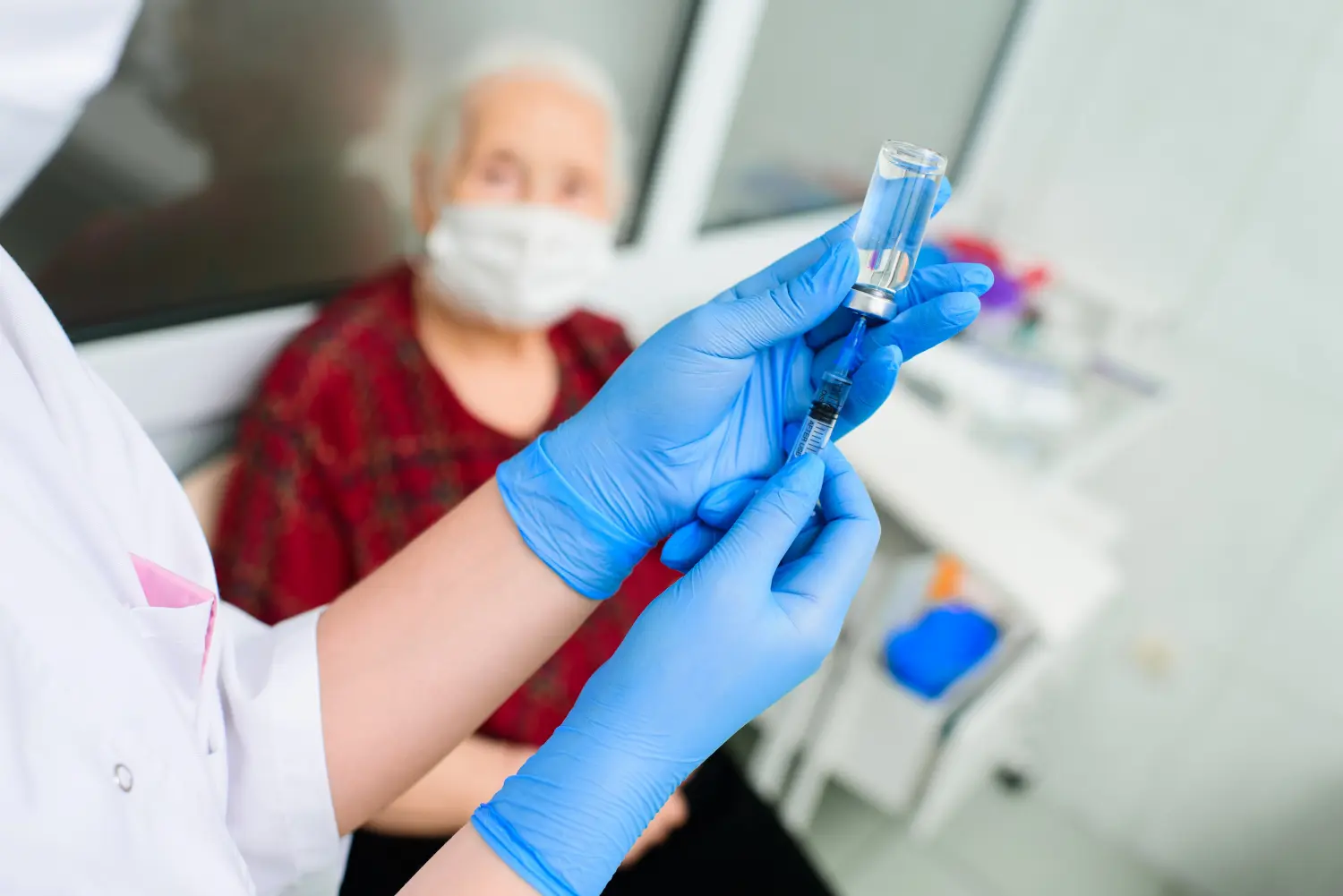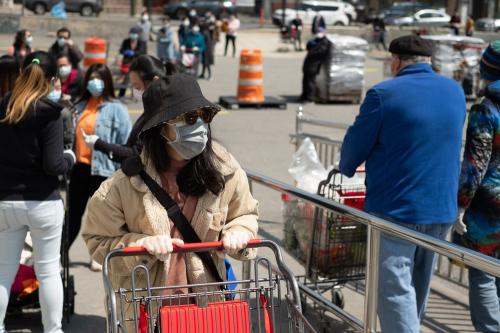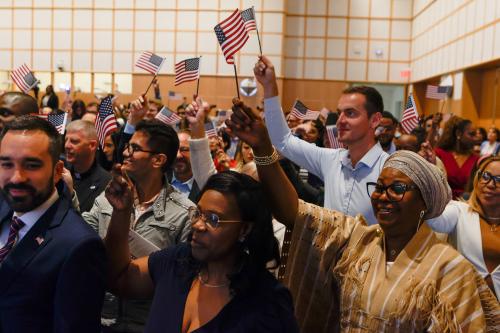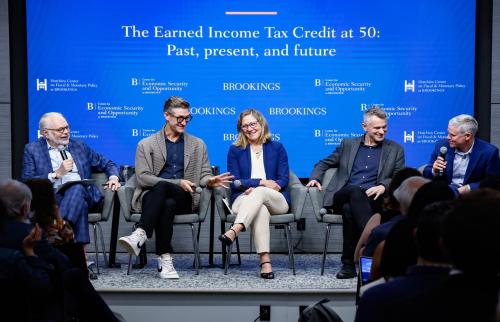The arrival of the more infectious delta variant of COVID-19 in the United States makes increasing vaccination rates more important than ever. Much has been made of the strong relationship between the political leanings of an area and its vaccination rate, but we show that this relationship is weaker for two higher risk groups—the elderly and nursing home residents. In fact, state-level vaccination rates for nursing home residents are virtually uncorrelated with a state’s political leanings, as measured by Trump’s share of the 2020 vote. Instead, flu vaccination rates for nursing home residents measured prior to the pandemic are highly predictive of COVID-19 vaccination rates for this population, suggesting that more traditional causes of under-vaccination are at play.
Political polarization and misinformation are important barriers to vaccination. However, attention to more traditional sources of vaccine hesitancy—lack of trust in the medical system due to medical racism or other reasons, concerns about side effects and efficacy, and barriers to access—is also warranted. Our analysis of nursing home facility-level data shows that Black residents are particularly likely to be in higher-risk facilities where vaccination rates among both residents and staff are low. High-risk facilities are concentrated in the South and Southwest and tend to be in communities with low vaccination rates and high COVID-19 infection rates. Increasing vaccination rates for nursing home residents and staff may prove difficult, but we need to redouble efforts to protect this vulnerable population.
Vaccinating high-risk people is especially important
While vaccines confer protection against adverse COVID-19 outcomes for any individual who takes them and helps slow the spread of the disease, vaccinating those most vulnerable will do the most to reduce the number of people who become seriously ill or die in the delta wave. Nursing home residents are perhaps the most at-risk population, accounting for more than a third of COVID-19 deaths before vaccines became available. The vaccines work well in this population: After a slow start, the campaign to vaccinate nursing home residents brought the third wave to a dramatic end (Figure 1).

COVID-19 vaccination is politicized but less so for high-risk populations
Vaccination rates vary considerably across states, and political polarization has played an important role in vaccine hesitancy: polls show that hesitancy is high among Republicans, and at the state level Trump’s share of the two-party vote in 2020 correlates strongly with vaccination rates (Figure 2). But vaccination rates are higher and less related to Trump vote share at older ages—where the risk associated with contracting COVID-19 is higher. For every one percentage point increase in Trump vote share, the vaccination rate declines by about one percentage point for teens, 0.8 percentage points for non-elderly adults, and 0.4 percentage points for elderly adults.

COVID-19 vaccination rates among nursing home residents follow similar patterns as pre-pandemic flu vaccination rates
Vaccination rates among nursing home residents are essentially unrelated to Trump vote share at the state level (Figure 3, left panel). On the other hand, pre-pandemic flu vaccination rates for nursing home residents strongly predict COVID-19 vaccination rates for this population (Figure 3, right panel).1 Notably, state-level, pre-pandemic flu and COVID-19 vaccination rates for non-elderly adults are uncorrelated, consistent with the idea that unusual COVID-19 specific factors such as political identity are more important for explaining COVID-19 vaccine hesitancy in lower-risk populations and could become less of factor as the spread of delta increases COVID-19 risk.
Nursing home residents are vaccinated for COVID-19 at substantially higher rates than is typical for flu, especially in states with low flu vaccination rates. For example, in Nevada less than half of residents were vaccinated for flu prior to the pandemic, but more than 70 percent received a COVID-19 vaccine. This may be because the risk associated with COVID-19 is higher—and the vaccine more effective—compared to the flu.

This suggests that the factors responsible for variation in flu vaccine uptake among nursing home residents likely play a more prominent role for COVID-19 vaccination uptake than political identity. Research on the behavioral factors underlying vaccine hesitancy among nursing home residents specifically is scarce, but studies of the community-dwelling elderly show that the most consistent predictors of vaccine hesitancy include perceptions that the vaccine is not effective or the flu is not severe, concern about side effects, and lower education and income. Elderly people who are Black or Hispanic, younger, unmarried, or not part of a high-risk group are also less likely to receive a flu vaccine. Research on flu vaccination in nursing homes using administrative data finds that resident age and race, facility type, and location are correlated with flu vaccination rates. In analyses we discuss below, we find that these are also correlates of COVID-19 vaccination.
COVID-19 vaccination rates for nursing home staff are low
Nursing home staff face elevated risk of contracting COVID-19, and close to 2,000 have died of the disease. Despite this, only about 60% of nursing home staff nationally are fully vaccinated and that number is below 50% in seven states. Nursing home staff vaccination rates follow similar patterns to the adult population; the correlation with Trump vote share is between that for non-elderly adults and elderly adults, with a slope of -0.61 (Figure 4).

Progress on vaccinating nursing home residents and staff has stalled
For the week ending June 13 (the earliest date for which most facilities reported this information), nursing homes reported that 80% of residents and 57% of staff were fully vaccinated. For the week ending July 25 (the most recent data available2), those numbers had increased only slightly to 82% and 61%, respectively. In May, the Centers for Medicare and Medicaid Services (CMS) issued regulations requiring nursing homes to educate residents and staff about COVID-19 vaccines and provide opportunities to get vaccinated. Vaccination data were not collected before these rules, so it is not clear whether they had much impact.
Low-vaccination rate facilities are concentrated in the South and Southwest and disproportionately serve Black residents
Facilities where vaccination rates among both residents and staff are low are most at risk, especially if vaccination rates in the community are also low. We classify facilities into three groups3:
- Highest risk: Less than 75% of residents and 50% of staff are fully vaccinated
- Lower risk: At least 90% of residents and 75% of staff are fully vaccinated
- Medium risk: All other facilities
For the week ending July 25, we identify 1,562 facilities serving 126,080 residents in the highest risk category, 10,241 medium risk facilities serving 787,870 residents, and 1,912 lower risk facilities serving 138,099 residents. Table 1 shows the characteristics of facilities by risk category. Lower risk facilities serve residents who were on average older—which may indicate that higher risk residents were more vaccinated—and substantially more likely to be white.4
Black residents are especially at risk. About 25% of residents of high-risk facilities are Black, compared to only about 8% of residents in low-risk facilities (Table 1). Only 11% of facilities are in the highest-risk category according to this definition, but still about 20% of Black residents are in high-risk facilities, compared to 5% of Asian, 10% of Hispanic/Latino, and 11% of white residents. (These calculations assume the racial composition of facilities has not changed systematically since February 1, 2020; see footnote 4). Compared with low-risk facilities, higher-risk facilities are larger, more likely to be for-profit, and have lower quality ratings. High-risk facilities were also disproportionately located in the Southern and Southwestern regions of the U.S., and in counties with lower vaccination rates.5 We cannot pinpoint precisely the mechanisms underlying these patterns with the available data, but special attention should be paid to these high-risk facilities and their residents as delta spreads.
What can be done to increase vaccination rates among nursing home residents and staff?
The COVID-19 vaccine is easily available to nursing home residents, and based on influenza research, only a small share have medical contraindications, so the vast majority of unvaccinated nursing home residents have chosen not to be vaccinated (or their medical proxy has done so on their behalf). Our findings above suggest that nursing home residents who have not taken the COVID-19 vaccine are likely a select population that is traditionally difficult to vaccinate. Unfortunately, there is little research on interventions that work to increase vaccination rates among nursing home residents. No single policy change or strategy will increase vaccination substantially on its own, especially since many facilities are short-staffed and suffer from frequent turnover, making it difficult for staff to take the time to build the trusting relationships necessary to overcome resident’s vaccine hesitancy. Still, given the risk this population faces, nursing homes should redouble efforts to get residents vaccinated with appropriate state and federal assistance.
Nursing home staff were among the first to be offered access to COVD-19 vaccines and continue to have easy access, so low vaccination rates for this groups are also largely driven by hesitancy. Systematic data on why nursing home staff do not want to be vaccinated are not available, but focus groups suggest they decline the COVID-19 vaccine largely for the same reasons as the general population. Misinformation appears to be an important factor, but so is concern over the vaccines’ safety given the quick development of a new technology.
Vaccinating more nursing home staff would go a long way towards protecting residents as well as staff, and it may be easier to make progress on this front given the high share that is unvaccinated. Evidence suggests that interventions that educate health care workers about vaccines may modestly improve vaccination rates among nursing home staff.
Making vaccination a condition of employment has proved effective for some types of health care workers, and there is precedent for mandating vaccines for nursing home staff—18 states mandate flu vaccines. Mandates are legally permissible even though the COVID-19 vaccines are under emergency use authorization. Following the lead of several states—including California, Connecticut, and Massachusetts—which recently announced they will require nursing home staff to be vaccinated, the Biden administration has announced plans to require nursing home facilities to implement staff COVID-19 vaccine mandates or lose federal funding. The administration has not announced details, but other vaccine mandates allow staff to opt out on religious and/or philosophical grounds. Long-term care experts have noted that direct care staff are already in short supply, so facilities may be reluctant to enforce the mandate strictly if exceptions are allowed.
Full approval of the COVID-19 vaccines from the Food and Drug Administration may also promote vaccination by alleviating some concerns among vaccine-hesitant staff. Ensuring that staff receive paid time off if they experience side-effects, which employers can be reimbursed for under the American Rescue Plan, may also help. States, governments, or facilities themselves could also consider offering financial incentives for nursing home staff to become vaccinated. A vaccination bonus of $200 per worker would cost on the order of $140 to $340 million, depending on whether it included staff who were already vaccinated (for fairness reasons), eligibility, and take-up.6 This would be a large outlay, but is small relative to the potential benefits of reducing the spread of COVID-19 in nursing homes. By comparison, at least 18 states have promoted vaccination in the general population with six- or seven-digit lottery prizes, spending close to $80 million.
Increasing vaccination rates among nursing home residents and staff may prove difficult but will be incredibly valuable. Policymakers, public health officials, and nursing home facilities should redouble existing efforts and experiment with new approaches to improve vaccination rates among these populations.
The Brookings Institution is financed through the support of a diverse array of foundations, corporations, governments, individuals, as well as an endowment. A list of donors can be found in our annual reports published online here. The findings, interpretations, and conclusions in this report are solely those of its author(s) and are not influenced by any donation.
Dr. Kosar’s effort was supported by grants P01AG027296 and U54AG063546-02S2 from the National Institutes of Health – National Institute on Aging, which had no role in the analyses presented. Other than the aforementioned, the authors did not receive financial support from any firm or person for this article or from any firm or person with a financial or political interest in this article. They are currently not an officer, director, or board member of any organization with an interest in this article.
-
Footnotes
- Political identity may play some role for nursing home residents: Controlling for pre-pandemic flu vaccination rates or racial composition, the relationship between Trump vote share and COVID-19 vaccination rates for nursing home residents is negative and significant, but much weaker than for other groups.
- The most recent NHSN is for the week ending August 1, but the data on staff and resident vaccination for the most recent week are incomplete (some facilities report vaccination data with an additional week’s lag), so we use the data from one week earlier.
- The cutoffs we use here are arbitrary and are meant to shed light on the characteristics of facilities with different vaccination rates rather than provide a systematic assessment of COVID-19 risk in nursing homes. Not all nursing homes are included in this analysis because one or more data elements are missing. Some facilities report 0% vaccinated, which is usually inconsistent with reports in surrounding weeks; we recode these to missing.
- Data on the characteristics of current nursing home residents are not available; instead, we use the race and age distributions of nursing home residents as of February 1, 2020 (prior to the pandemic) constructed from the Medicare Minimum Data Set. Most nursing homes serve a similar population over time. However, because many nursing home residents have died of COVID-19 and many people who would have entered a nursing home in normal times have sought out other options because of the COVID-19 risk, nursing home occupancy is down since February 2020. Since some groups are more likely to have other options, the composition of nursing home residents may have changed during the pandemic. The decline in post-acute-care residents has been larger than for long-stay residents; if we use the racial and age composition of long-stay residents, the findings are similar. Still, we note that the age and race composition variables are measured with error.
- Although many of these resident and organizational factors are inter-related (for example, nursing homes in the South serve more Black residents, and facilities serving Black residents also have lower quality ratings, on average), regression analyses considering multiple characteristics at the same time confirm that these factors are independent predictors of facility vaccination rates for residents. The relationship between staff vaccination rates and the racial composition of residents is more sensitive to which other variables are included in the regression. In any case, we cannot draw strong causal conclusions from this analysis, and future work should explore these relationships in more detail.
- Nursing homes reported 1.7 million health care personnel who were eligible to work at least one day in the most recent NHSN, about 60% of whom are unvaccinated, but this is an over-estimate because many staff work in multiple facilities or are eligible to work but don’t. On the other hand, NHSN only covers Medicare-certified long-term care facilities, and it would likely make sense to include workers in assisted living facilities and home health care workers in such a program. A program covering the upper bound of 1.7 million nursing home staff alone with 100% take-up would cost $340 million; a program covering only 1 million unvaccinated staff with 70% take-up would cost $140 million.
The Brookings Institution is committed to quality, independence, and impact.
We are supported by a diverse array of funders. In line with our values and policies, each Brookings publication represents the sole views of its author(s).







